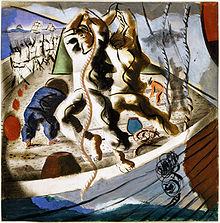Candido Portinari

Candido Portinari (born December 29, 1903 in Brodowski ( state of São Paulo ), † February 6, 1962 in Rio de Janeiro ) was a Brazilian painter . With around five thousand works, from small sketches to gigantic wall paintings , he is still the most internationally famous painter in Brazil .
Born as the son of Italian immigrants on a coffee plantation in the state of São Paulo, Portinari studied at the Escola Nacional de Belas Artes (National School of Fine Arts, ENBA) in Rio de Janeiro . In 1928 he won a gold medal at this school and a trip to Paris , where he stayed until his return to Brazil in 1930. He became a member of the Communist Party of Brazil and ran for election as senator in 1947, but had to flee to Uruguay because of the persecution of communists . He returned to Brazil in 1951, spent the last decade of his life in poor health and died in 1962 of lead poisoning due to the lead content of the paints he used.
Professionally, he worked with the architect Oscar Niemeyer , among others . Portinari's exhibited works can be found in Brazil and abroad and range from the family chapel in the house where he was born in Brodowski to his large paintings Guerra e Paz (War and Peace) in the UN building in New York .
Web links
- Brazilian Embassy: Fine Arts
- Museu Casa de Portinari, Brodowski
- Instituto Itaú Cultural: Candido Portinari. In: org.br. Enciclopédia Itaú Cultural (Brazilian Portuguese).
Individual evidence
- ^ João Candido Portinari fala sobre o Projeto Portinari e sua trajetória. March 30, 2012, accessed on July 22, 2020 : "Até seu nome foi distorcido: pode-seounter até hoje na internet instâncias em que ele é chamado de" Candido Torquato Portinari ". O nome correto é "Candido Portinari" (assim mesmo, sem acento circunflexo). "
| personal data | |
|---|---|
| SURNAME | Portinari, Candido |
| BRIEF DESCRIPTION | Brazilian painter |
| DATE OF BIRTH | December 29, 1903 |
| PLACE OF BIRTH | Brodowski , State of São Paulo |
| DATE OF DEATH | February 6, 1962 |
| Place of death | Rio de Janeiro |
